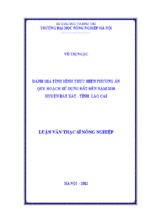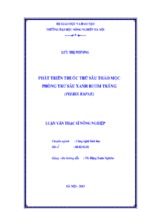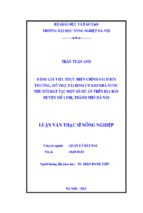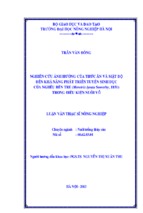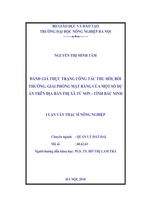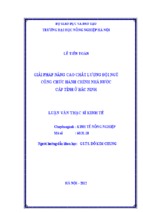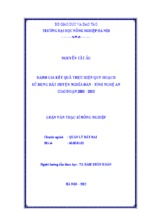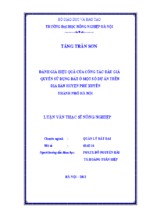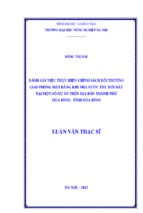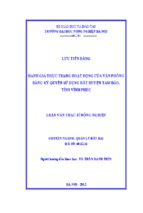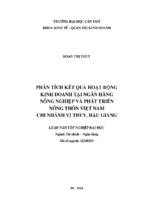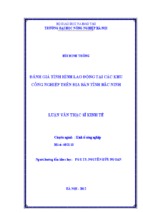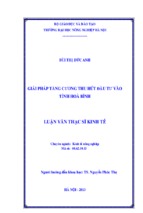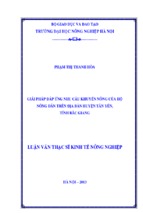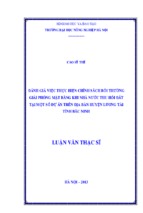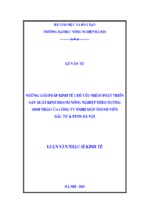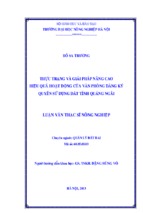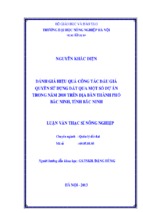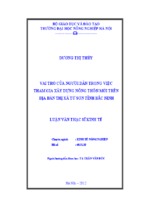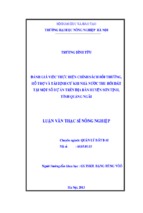THAI NGUYEN UNIVERSITY
SCHOOL OF FOREIGN LANGUAGES
NGUYEN THI THU HIEN
HIGH SCHOOL TEACHERS’ EMPLOYMENT OF FIRST
LANGUAGE IN THEIR ENGLISH CLASSROOM INSTRUCTION
(Việc sử dụng ngôn ngữ thứ nhất khi dạy tiếng Anh trên lớp học của
giáo viên Trung Học Phổ Thông)
M.A THESIS
Field: English Linguistics
Code: 8220201
THAI NGUYEN – 2019
THAI NGUYEN UNIVERSITY
SCHOOL OF FOREIGN LANGUAGES
NGUYEN THI THU HIEN
HIGH SCHOOL TEACHERS’ EMPLOYMENT OF FIRST
LANGUAGE IN THEIR ENGLISH CLASSROOM INSTRUCTION
(Việc sử dụng ngôn ngữ thứ nhất khi dạy tiếng Anh trên lớp học của
giáo viên Trung Học Phổ Thông)
M.A. THESIS
(APPLICATION ORIENTATION)
Field: English Linguistics
Code: 8220201
Supervisor: Nguyen Thi Hang, Ph.D.
THAI NGUYEN – 2019
STATEMENT OF AUTHORSHIP
The thesis entitled “High school teachers’ employment of first language in their
English classroom instruction” has been submitted to School of foreign languages,
Thai Nguyen University for the Master of English language.
I hereby declare that this thesis and the work presented in it are my own and
have been generated by me as the result of my own original research. All references
and all sources of information used in it have been specifically acknowledged.
My thesis does not contain work extracted from a thesis, dissertation or research
paper previously presented for another degree or diploma at this or any other
universities.
Signature: ..................................
Name: Nguyen Thi Thu Hien
Date: ........./............/2019
Approved by
Signature:
Dr. Nguyen Thi Hang
i
ACKNOWLEDGEMENT
I would like to acknowledge my indebtedness and render my warmest thanks
to my supervisor, Dr. Nguyen Thi Hang, who made this work possible. I am grateful
to her for her patience, her encouragement and insightful suggestions.
My special thanks are definitely to high school teachers in Quang Ninh
province who agree to participate in my study. During my Data collection, they
always provide me with great help.
I would like to extend my thanks to my family: my mother, my husband and
my daughter, who are always by my side and encourage me to accomplish this thesis.
ii
ABSTRACT
This study investigates the practice of code switching among English language
teachers at high school in Vietnam with practical experience in English as a foreign
language. It places a focus on the situations in which teachers use their first language
within their English instruction in their English classroom, and the reasons why
teachers utter Vietnamese when giving instruction of English in their classes.
An ethnographic research design is applied in the study. The research is based
on the data analysis of four typical high school teachers’ code switching from three
sources of information: class observations, class recordings, and interviews with
teachers.
It was found that the teachers practiced code-switching very commonly in their
English instruction in different situations such as presenting vocabulary, presenting
pronunciation, presenting grammar rules, correcting mistakes and keeping class
management. Specific examples were illustrated and interpreted in each situation to
provide the context where the teachers practised code switching.
At the same time, the reasons why they code switched were revealed. These
ranged from the teachers’ personal reasons to those for students’ sake: students’
English proficiency, time saving strategy and teachers’ habits. Among which,
students’ low level of English was the most popular factor that teachers took into
consideration when deciding to use their first language frequently.
Based on the findings of the study, recommendations are provided for English
teachers for situations where teachers’ code-switching could be encouraged and many
other situations, their code-switching should generally be avoided.
iii
TABLE OF CONTENTS
STATEMENT OF AUTHORSHIP ......................................................................... i
ACKNOWLEDGEMENT ....................................................................................... ii
ABSTRACT ............................................................................................................. iii
LIST OF TABLES .................................................................................................. iv
ABBREVIATIONS ...................................................................................................v
PART A. INTRODUCTION ....................................................................................1
1. Rationale ..............................................................................................................1
2. Aims of the study .................................................................................................2
3. Scope of the study ................................................................................................2
4. Structure of the study ...........................................................................................3
PART B. DEVELOPMENT .....................................................................................3
CHAPTER 1. LITERATURE REVIEW ................................................................3
1.2. Code-switching in classroom instruction .........................................................6
1.2.1. Viewpoint supporting the use of L1 in language classes ............................6
1.2.2. Viewpoint against the use of L1 in language classes. ................................7
1.3. Studies of teachers’ using L1 in language classrooms .....................................8
1.4. Summary .........................................................................................................10
CHAPTER 2. METHODOLOGY .........................................................................11
2.1. Methodology of the study ...............................................................................12
2.2. Participants......................................................................................................13
2.3. Data collection ................................................................................................13
2.3.1. Classroom observations ...........................................................................14
2.3.2. Post-observational interviews ..................................................................15
2.4. Data analysis ...................................................................................................16
2.5. Summary .........................................................................................................17
CHAPTER 3. FINDINGS AND DISCUSSION ...................................................17
3.1. Code-switching situations ...............................................................................17
3.1.1. Explaining new words ..............................................................................18
3.1.2. Presenting grammar rules ........................................................................21
3.1.3. Correcting mistakes ..................................................................................22
3.1.4. Dealing with class management ...............................................................24
3.2. Reasons for teachers’ code-switching ............................................................25
3.2.1. Students’ English proficiency ...................................................................26
3.2.2. A time saving strategy ..............................................................................28
3.2.3. Teachers’ habits .......................................................................................29
3.3. Summary .........................................................................................................33
PART C. CONCLUSION AND RECOMMENDATIONS .................................34
1. Conclusion .........................................................................................................34
2. Recommendations for the teachers ....................................................................35
3. Limitations and Recommendations for further studies ......................................37
REFERENCES ........................................................................................................38
APPENDICES ........................................................................................................... I
LIST OF TABLES
Table 1. Summary of teacher participants………………………………………13
Table 2. Summary of teachers’ code-switching situations…………………….. 18
Table 3. Summary of reasons for teachers’ code-switching…………………… 26
iv
ABBREVIATIONS
EFL: English as a foreign language
FL: Foreign language
L1: Language one
L2: Language two
TL: Target language
v
PART A. INTRODUCTION
1. Rationale
There have been ongoing debates about teachers’ use of languages,
particularly whether they should use their first language in their English classes. On
the one hand, using the first language (L1) in foreign language classrooms is
discouraged by advocates of the target language (TL) use only (Chauron, 1988;
Mcdonald, 1993). These authors contend that students must be exposed to a
significant amount of TL input if they want to develop it better. This explains why
teachers of English can sometimes receive criticism for using their first language in
their classroom instruction. At the other end of the spectrum, a number of scholars
including Eastman (1992), and Addendorff (1993), Code-switching amongst Luzuspeaking teachers and their pupils: Its functions and implications for teacher
education, Language and Education, 7(3), 141-161. feel that switching from TL to
L1 can be an effective strategy for teachers to help improving their students’ TL
proficiency if L1 is deliberately utilized in classrooms. Cook (2001, pp.402-423) also
provides guidelines for teachers when employing L1 in classroom instructions, which
are “efficiency”, “learning”, “naturalness” and “external relevance”.
These contrasting viewpoints reflect what I have observed and questioned for
years during my teaching career at Van Lang high school in Ha Long, which has
driven me to investigate the English teaching setting of high schools in Vietnam,
where the teachers’ use of L1 in instruction is a common element. From my own
experience and my observation of other English teachers’ teaching practice, it is
evident that Vietnamese teachers use both L1 and English in different phases in their
language classroom.
It is a common perception that when the teachers use Vietnamese, their
students might better comprehend the instructions. Especially in classes with English
low-level students, if L1 is not used, tasks and activities must be kept simplest to
ensure that the instructions are understandable, which might result in teachers treating
high school students like kids rather than intelligent and sophisticated people (Gunn,
1
2003). In other cases, some teachers resort to Vietnamese with a view to saving time
and effort of explaining and understanding, which may somehow solve the problem
of class time limit. However, it would turn out to be negative if this practice becomes
a habit and both students and teachers accept Vietnamese as a matter of fact in a
language classroom. This issue has given me a desire to understand when and for
what reasons teachers at high school employ L1 in classroom instruction.
The study entitled “High school teachers’ employment of first language in
their English classroom instruction” will hopefully give high school teachers an
opportunity to reflect on their own teaching practice and use code switching as an
effective strategy by utilizing Vietnamese deliberately in classroom instruction.
Besides, it raises awareness of language alternation in classroom instruction, not only
among teachers of the high school chosen in the research but also among language
teachers in other similar teaching and learning contexts in Vietnamese.
2. Aims of the study
The study aims to investigate English language teachers at a high school in
Vietnam with practical experience in English as a foreign language (EFL). It places
a focus on the situations in which teachers use their first language (Vietnamese)
within their English instruction in their English classroom. Moreover, the study
provides the evidence of reasons why teachers utter Vietnamese when giving
instruction of English in their classes.
Research questions:
When do high school teachers employ their first language in their classroom
instruction?
Why do high school teachers employ their first language in their classroom
instruction?
3. Scope of the study
This study focuses on teachers’ use of their first language in their classroom
instruction of English. It will be conducted during the academic year of 2018 – 2019.
2
4. Structure of the study
The study is composed of three main parts as follows.
Part A: Introduction provides the background to the study, the aims of the
study which is followed by the research questions, the significance of the study and
the organization of the study as well.
Part B: Development consists of three chapters
Chapter 2: Literature Review is an overview of the related topics that
provides the theoretical background to the study including theoretical background of
code switching. Some previous studies about teachers using L1 in foreign language
classes are mentioned in this chapter to be the references of the study.
Chapter 3: Methodology describes the research design, the data
collection instruments used and the procedures of data collection, the description of
the participants and data analysis.
Chapter 4: Findings and discussion analyses all the data collected
from the study, including the results from observation notes, recordings and interview
transcriptions.
Part C: Conclusion and Recommendation concludes the thesis by
summarizing the findings, discussing the contribution of the study, limitations and
suggestions for further studies.
PART B. DEVELOPMENT
CHAPTER 1. LITERATURE REVIEW
Using the first language in foreign language classes has received great
attention from language researchers. This chapter, consisting of four sections,
3
reviews relevant matters related to code-switching as the background for the study.
First, it briefly discusses an overview of the notion of bilingualism and one of its main
characteristics - the phenomenon of code-switching. The next section provides a
number of different viewpoints in regard to the practice of code-switching in
classroom instruction of English. These main viewpoints come from those who are
for and against the L1 use. The third section aims to synthesise previous studies of
teachers’ L1 using in language classrooms. The chapter ends with a summary of the
main points presented.
1.1. Bilingualism and code-switching
Bilingualism is the phenomenon of speaking and understanding two or more
languages. The term can refer to individuals (individual bilingualism) as well as to
an entire society (social bilingualism).
There have been different views on bilingualism and bilinguals. One of the
most common views is bilingualism is defined based on the level of language
proficiency of the speaker of the two languages. Accordingly, bilinguals are divided
into three groups as follows.
According to Mackey (2000), bilinguals refer to speakers who can use two
languages equally fluently. This means if someone is called a bilingual, he or she
must master the second language, more or less, than their mother tongue in all the
four skills: listening, reading, writing and speaking. With this definition, the number
of bilinguals is limited. At the other end of the spectrum, those educators like Haugen
(1953) claims that bilinguals are those who master one language and at the same time
can show certain level of proficiency of another language. In his view, bilinguals refer
to anyone who can demonstrate their ability of using second language (even at a basic
level). The last category of bilinguals is proposed by Edwards (2004) and Mackey
(2000) who believe that bilinguals are those who are able to use two languages
alternately.
In this study, I adopt the third definition which emphasizes on the teachers’
4
alternate use of English and Vietnamese in their English classes to be bilinguals. The
teachers’ use of both languages is known as one of the three main features of
bilingualism, the phenomenon of code-switching, which occurs when a speaker
alternates between two or more languages in conversation. Instances of codeswitching, like the following examples, commonly occur around the classroom
context.
Examples:
(a) Cuối tuần này đi picnic đi.
(b) Keep silent please. Cả lớp trật tự được chưa?
(c) Giờ tôi không thể nhớ chính xác cái moment ấy như thế nào […]
In the above examples, the speaker starts in one language (Vietnamese in this
case), then he or she shifts to English. His/her switches maybe forth and back.
This phenomenon has been long discussed; however, there has not been an
agreed definition. Nunan and Carter (2001) simply define code switching as “a
phenomenon of switching from one language to another in the same discourse”.
Simon (2001) describes foreign language teachers’ code-switching as the teachers’
choice of using the language being taught and the teachers’ and students’ first
language.
Another definition of code-switching proposed by Hoffmann (1991) is “the
alternate use of two languages or linguistic varieties within the same utterance or
during the same conversation” (p. 110). This definition is supported by Muysken
(1995) who defines bilingualism as “the alternative use by bilinguals (or multilinguals) of two or more languages in the same conversation”. In this perspective,
code-switching is identified by Gardner-Chloros (2009) as “the use of several
language dialects in the same conversation or sentence by bilingual people” (p. 4).
Similarly, code-switching is used to refer to the phenomenon in which “speakers
switch backwards and forwards between distinct codes in their repertoire” (Bell,
2014, p. 111).
5
In the language classroom context, code-switching has been defined as “the
systematic, alternating use of two or more languages in a single utterance or
conversational exchange” (Levine, 2011, p. 50). More specifically, G. Cook (2010)
refers to the teacher’s code-switching as the use of the first language in his/her L2
classroom. G. Cook (2010) also sees translation as one means for a bilingual to codeswitch. However, he notes that teachers’ L1 use does not necessarily involve
translation because translation is not the only tool for a bilingual to use.
In the context of the language classroom in Vietnam, teachers’ code-switching
seems to be a common practice in their classroom instruction of English, and it is
seen as “the practice of using two languages within the same utterance and between
utterances and turns” (Nguyen, 2013; Grant & Nguyen, 2017).
1.2. Code-switching in classroom instruction
Teachers’ code-switching in classroom instruction involves their alternate use
of the first language (L1) and the second language (L2). There have been disputes
among scholars on teachers’ using only L2 and on their using both the L1 and L2 in
the FL classrooms. The viewpoint that approves of the teachers’ use of two languages
means their code-switching is, to a great extent, accepted. In contrast, there are those
who disparage this practice, viewing that a degree is a more of hindrance than a help
if language teachers insert their L1 into their instruction in class.
These two
contrasting views are, in turn, reviewed as follows.
1.2.1. Viewpoint supporting the use of L1 in language classes
The advocates of L1 employment in language classroom base their support on
such ideas that teachers can use L1 with specific purposes. Tang (2002), for example,
claims that L1 can be used by teachers to give instructions and explain complex
grammar and difficult ideas. This is a common view of the supporters of the Bilingual
Approach, i.e. the one which advocates L1 use. Miles (2004, p.8) states that “the
Bilingual Approach might argue that to make the separation or distinction between
L1 and L2, explanations in L1 are necessary, because the teaching of grammar is so
6
complex, that without L1 use, there would be little or no comprehension on the
students’ part, especially at lower levels.”. Sharing the same opinion, Nunan (1997)
believes that the exclusion of L1 in lower-level monolingual classes is practically
impossible.
More specifically, Cook (2001) also provided two reasons for employing the
first language in an FL class, which are efficiency and naturalness. He proposed
various ways for teachers to use their native language positively in their FL classes
such as to convey meaning, explain grammar, organize tasks, manage the classroom,
establish and maintain contact with individual students an administer tests.
Another reason leading to teachers’ use of their mother tongue is the fact that
non-native speakers account for the vast majority of teachers of English across the
world (Hawks, 2001, cited in Miles, 2004, p. 9). These teachers normally find it hard,
or even impossible to carry out the English-only teaching in the classroom; thus, the
insistence on the monolingual approach may result in their reduced ability to
communicate and consequently their reduced teaching performance (Miles, 2004,
p.9).
1.2.2. Viewpoint against the use of L1 in language classes.
Although the use of L1 tends to gain more support from some L2 researchers,
there are many who have argued that the use of L1 should be limited in L2 instruction.
These opponents of L1 provide evidence to support their argument.
One of the first arguments is that the use of L1 may have negative effects on
the instructors’ use of L2 because if instructors use L1, the quantity of
comprehensible L2 input decreases, which is thought to do harm to learners’ L2
learning. Years ago, Mitchell, (1983) argued that adult L2 learning should take place
in the same way as child L1 learning and that the L2 should be ‘‘largely acquired
rather than consciously learned, from message-oriented experience of its use’’ (p.41).
Later, Polio & Duff (1994) viewed the use of L1 as characteristic of the old- fashioned
grammar translation method, which largely focused on translating from L2 to L1 as
7
a way of learning the L2.
Other authors who are of the viewpoint against the use of L1 believe that L2
teaching should take place without interference from L1. According to Cummins
(2007), the dominant approach in L2 teaching has advocated no use of L1 in L2
classrooms. Thus, many language teaching approaches continue to assume that L2
instruction should be mainly through the L2 and that if there is recourse to the L1, it
should be minimized as much as possible (Turnbull, 2001). Some even may believe
that instructors should avoid using L1 altogether and that those who use it may be inadequate pedagogues (Cook, 2001).
1.3. Studies of teachers’ using L1 in language classrooms
Studies of teachers’ use of L1 in classroom vary. Duff & Polio (1990) found
that although instructors acknowledge the importance of teaching in L2, most of them
still use L1 to a certain degree in their classrooms Studies have also found a large
variability of L1 use among teachers. They examined the use of L1 in foreign
language classes taught at the University of California and found L1 use ranging from
0 to 90%. They also found that teachers used L1 for a range of purposes, from
administration to grammar instruction and classroom management.
Other researchers, Nguyen (1999) and Zacharias (2003) reported their studies
on the use of L1 in L2 teaching and concluded that most of the respondents held
supportive views on the role of L1 in the English classroom. Zacharias (2003) further
pointed out the possible uses of L1 in the process of teaching L2 including explaining
the meaning of new words and grammatical points, giving instructions, checking
learners’ understanding and giving feedback to individual learners.
Many studies investigating teachers’ code-switching in classroom instruction
have found out the reasons why teachers of English switch to Vietnamese when
giving instruction.
There were different factors that led to the teachers’ code-switching found in
a number of studies (Greggio & Gil, 2007; Kang, 2013; Kim & Elder, 2008; Macaro,
2001; Rolin-Ianziti&Brownlie, 2002; Üstünel&Seedhouse, 2005). Such factors
8
examined in these research studies are grouped into two main categories: teacher
factors and student factors.
Kim and Elder (2008) looked into the practices and perceptions of two cases
of native speaker teachers (one is French and the other is Korean) of the TL in FL
classrooms in New Zealand. Four factors that caused teachers to code-switch were
shown in the analysis of their participants’ lesson transcripts. The first factor was the
teachers’ attitude towards TL use, i.e., their opinion about language teaching and
learning, their awareness of language use. The second factor was the teachers’
physical or mental state (e.g., the teachers’ impatience), the third factor was the
teachers’ language educational background, and the fourth factor was the teachers’
time pressure.
Other teacher factors arose from the classroom needs, e.g., to encourage
students to speak (Üstünel&Seedhouse, 2005) to make sure of students’
comprehension (Greggio& Gil, 2007), or to perform procedural instruction (Macaro,
2001; Rolin-Ianziti&Brownlie, 2002). Teachers code-switched to their first language
(Arabic) to deal with a cultural concept of, for example, Muslim people’s religious
cultural behaviour of performing ablution which occurs before praying because this
concept does not have an exact equivalent in English (Khresheh, 2012). In particular,
Le (2014) conducted a case study of a teacher in the Vietnamese university context,
and found that the teacher code switched because she underestimated the students’
ability in the target language. Furthermore, based on the evidence of the teacher’s
unnecessary switches, he claimed that many of the teacher’s switches from English
to Vietnamese in his study were habitual and automatic.
The student-related factors that caused teachers to code-switch were found in
far fewer studies. Kim and Elder (2008) found that the teachers in their study codeswitched because of the students’ poor level of English and the students’ physical or
emotional state, for example when they are unwell or unhappy. Other authors found
that teachers code-switched because they wanted their students to be relaxed or less
stressed (Greggio& Gil, 2007; Kang, 2013; Rolin-Ianziti&Brownlie, 2002). In these
studies, the students felt more comfortable or more relaxed in many situations when
9
their teacher code switched. In other words, their emotional state can be seen as a
motivation for their teachers to code-switch. This is a reason for teachers’ to codeswitch as Kim and Elder (2008) pointed out.
In sum, authors of interest have exploited various aspects in regard to teachers’
L1, also known as their code-switching. Good examples of these authors include
Macaro (2001) who examined the attitudes and perceptions of instructors and
students regarding the role of L1 in different contexts, Cook (2001) explored the
benefits for teachers’ use of their mother tongue teaching learners a foreign language.
Specifically, in the context of Vietnamese teaching and learning English, Nguyen
(2013), Grant and Nguyen (2017) provided an entire picture of teachers’ codeswitching, looking at the types and functions of code-switching, the situations where
their switches occur, the reasons for their switching and even the effects of their
switching on students language behaviour. They found that teachers switched forth
and back in many situations, when they dealt with both teaching content (grammar,
vocabulary and pronunciation) and classroom process. They, in their study, also
concluded that reasons for teachers’ switching vary, ranging from their personal
reasons (i.e. linguistic needs and teachers’ habitual and experiential practice) to
students’ reasons (i.e. students’ language ability and motivation).
1.4. Summary
In general, there were three main issues discussed in this chapter: bilingualism
and code-switching, code-switching in classroom instruction, and studies of teachers’
using L1 in language classrooms. About bilingualism, there seems to be no perfect
definition of bilingualism that serves all contexts. In this study context of FL
education, the definition which emphasizes on the teachers’ alternate use of English
and Vietnamese in their English classes to be bilinguals was adopted. Also, code
switching was defined as a common practice of using two languages (English and
Vietnames) in classroom instruction. There have been debates on the teachers’ use of
L1 in language classes. While many researchers advocated that teachers can use L1
with specific purposes, others argued that the use of L1 should be limited in L2
10
instruction. However, the use of the L1 occurs naturally and unavoidably in practice.
As a result, the code-switching phenomenon frequently occurs in the FL classes. It
appears in various situations including grammar and vocabulary presentation,
classroom management, mistake correction, or teacher-student communication.
Moreover, the reasons why teachers of English switch to Vietnamese when giving
instructions were also discussed in this chapter. Teacher factor and student factor are
the two main mentioned points that cause code switching in classroom instruction.
CHAPTER 2. METHODOLOGY
This chapter aims to briefly discuss ethnography as a theoretical approach that
the writer has applied to the study. It then, in the second section, presents the
participants involved in the study. The chapter continues with detailed descriptions
regarding the procedures in which the writer collected data and analyzed the obtained
information in the next two sections. A summary of the points presented closes the
chapter.
11
- Xem thêm -

